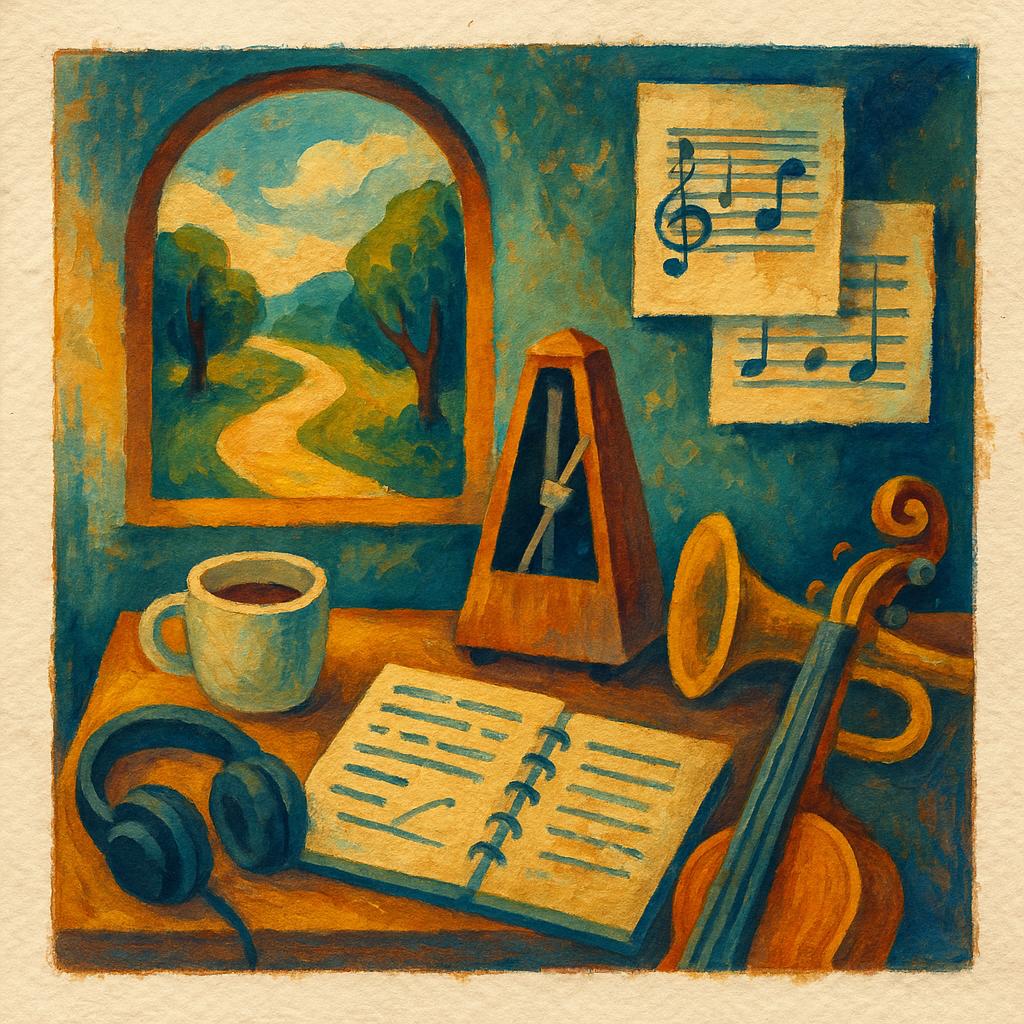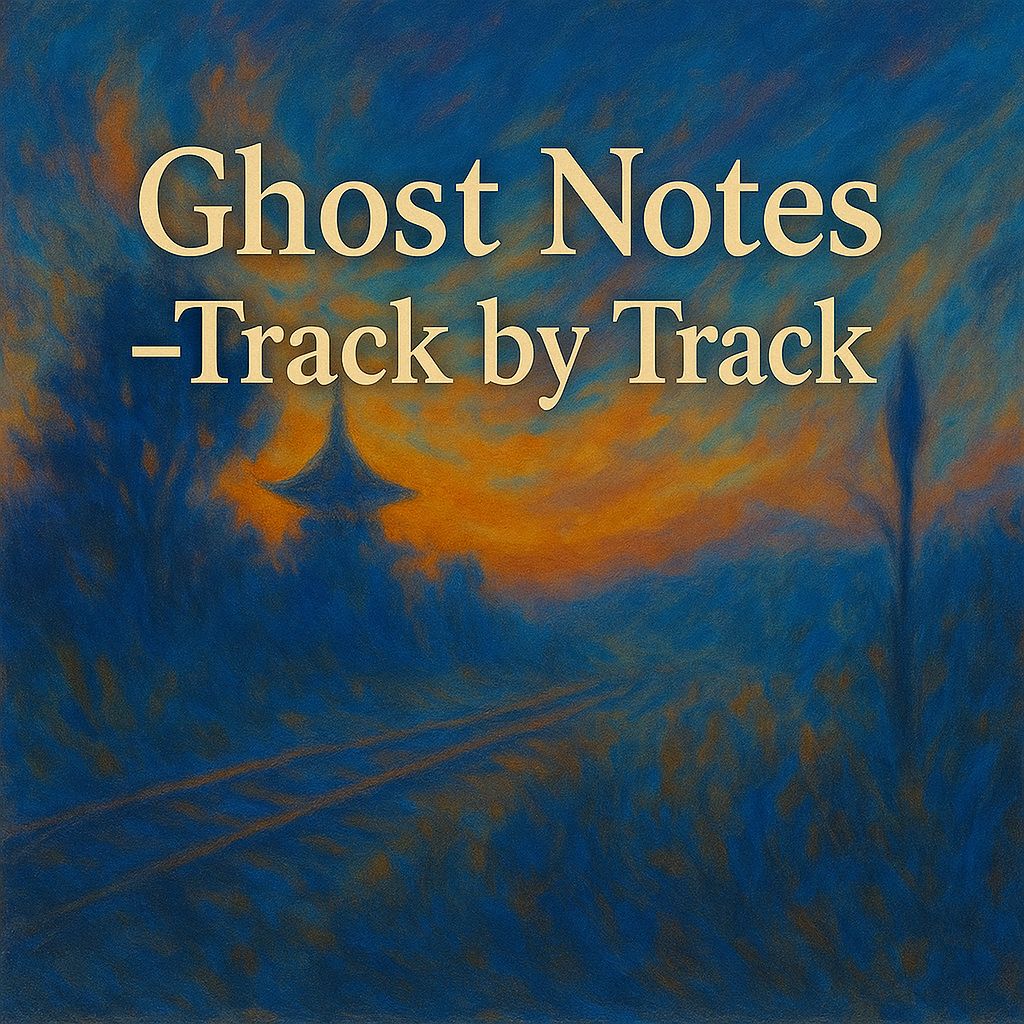This essay opens a window into the flow of a composing day – from the quiet preparation before the first note to the focused work that follows. It is meant for those who create music or any kind of art and sometimes wonder how to protect time, sustain clarity, and move from idea to completion without losing energy along the way. The reflections shared here are not instructions but gentle suggestions – small patterns that may help others find a steadier rhythm in their own creative days.
A productive composing day begins before the first note touches the keys. I decide in advance that the day will contain protected blocks for invention, decision, and polish. I mute alerts, close mail, and place a small card on the music stand with three lines only: today’s material goal, one precise constraint, and the first action I will take when I sit down. This tiny card keeps the day on a rail and prevents the swirl of options that quietly steals momentum.
Room, instrument, monitoring
The room plays as surely as any instrument. I work primarily with two pianos: an upright and a grand. With the upright piano, I open the top panel, move the back ten to twenty centimeters off the wall, and check pedal noise. With the grand piano, I set the lid on the middle prop to balance detail and air.
For string players, it helps to dust rosin near microphones and silence chair squeak. Wind players can choose a spot in the room where breath noise decays neatly. Guitarists should find and reduce left hand squeak zones and tame clothing rustle with a small cloth over the thigh.
Monitoring stays honest and modest: neutral speakers, moderate level, no hyped bass, and no “loudness as quality” trap.
I record at 48 kHz and 24 bit, leave peaks between minus twelve and minus six dBFS, and avoid dynamics on the way in. Clean gain leaves headroom for later judgment. While tracking I keep latency low; while editing or mixing I raise the buffer so the CPU stays calm. These choices are unglamorous, and exactly because they are unglamorous they work every day across instruments.
The warm start
Before I play I walk for five to ten minutes. I rehearse nothing during that walk. I just move, breathe, and notice the temperature. Back at the instrument I run the slowest scales I can tolerate and a few arpeggios without pedal. The point is not speed, but attention. When fingers, breath, and ear feel awake, the first block begins.
Block 1 – generating material
The first hour favors contrast and quantity. I keep several miniature ideas in parallel rather than grinding one section flat. My project has four lanes ready to roll: a close mic or DI lane, a room or ambiance lane, a guide lane for bass or voice leading, and a print lane for any effect I want to commit. In Ableton Live I keep two returns only, a short plate and a longer room, with no master trickery. In Pro Tools I use Playlists for takes so selection later stays orderly.
I record short phrases, four to sixteen bars, then mark and name them with tiny codes: ostA, liftB, bridgeC, bassD. After three to five minutes I deliberately switch to a different idea. That switch is not escape; it is method. Alternating content introduces small context shifts that keep the ear from adapting too quickly and force me to reframe the musical problem from different angles. Brass players can rotate between mute color, sustained tone work, and short riff cells. Drummers can rotate between stick family, surface choice, and limb grid at one fixed tempo. Guitarists can rotate between pick angle, open string use, and a temporary ban on downbeat bass. Keyboardists can rotate registral placement and pedal policy. The rule is simple: rotate on a timer, label everything, do not polish yet.
Noise and focus
For idea generation I allow a gentle noise bed. A slightly open window, a café loop at very low level, or the far hum of the street can help thought wander without dissolving into distraction. Because of my neurological and psychological condition, I often need to pause more frequently than most. Short breaks are not optional but structural. At times, I let a quieter Twitch stream or television program run softly in the background — not for attention, but as a neutral layer of sound that keeps the room from feeling closed in.
When accuracy matters – tuning chords, aligning attacks, balancing inner voices – I close the window, mute any source, and monitor quietly. A calm level protects judgment and ears and prevents the usual trap of confusing loudness with quality.
Notation and harmony
I notate sparingly. A few staff lines in the DAW or on paper are enough: key anchors, cadence waypoints, and counterline hints. I test whether the bass can sing alone and whether a listener could predict the cadence two bars early. If the bass feels like a staircase rather than a path, the harmony lacks a thread. Wind and brass players can test singability on a soft mouthpiece or by counting breaths; guitarists can speak rhythm syllables while ghosting left hand motions; percussionists can count stickings aloud and clap the skeleton rhythm. These simple probes reveal whether the line carries energy without production tricks.
Block 2 – developing and deciding
The second block selects and varies. From the morning haul I choose one or two ideas that carry weight and examine them with plain mechanical moves: sequence the cell by a third, invert the interval order, shift register, offset the rhythm, thicken then thin. I sketch a form in broad stations – entry, first fold, lift, contrast, return, resolve – and mark where breath, bow, or hand change will naturally occur. For piano I write the pedaling as words rather than symbols to keep intent clear. For winds I write breath points and keywork constraints. For guitar I note left hand positions per station so voicings stay idiomatic.
In Pro Tools I often anchor a tempo map to the body. I record a free take with a steady inner pulse, then use Identify Beat on cadential bars to lock the grid loosely to the music. The grid follows the playing, not the other way around. In Ableton Live I do the equivalent with a few warp markers placed only at structural points. With the grid floating around the take, overdubs inherit the same micro elasticity while editing remains simple.
Breaks and micro resets
Pauses are short and physical. Three to ten minutes away from the chair clears ear fatigue and restores energy. I stretch forearms and neck, focus my eyes on far distance, and drink water. No social feed, no inbox. If attention keeps drifting, a slightly longer walk resets the day. A tiny, well timed break often saves an hour of unfocused fiddling.
Block 3 – edit and balance
Now the work shifts from invention to care. I cut mechanical noise on piano only when it distracts, not by default. I retain pedal breath when it supports phrasing and trim only the sharp clicks.
For guitar, it is often better to leave the finger noise that tells the story of position changes and remove only the sudden jolts. For wind instruments, keeping the key noise that marks articulation while ducking clacks that stab holes in the line preserves natural movement.
Mono checks come early, because mono forces honest balance and reveals masking instead of hiding problems behind width. The monitor level stays low. A gentle high pass below 30 to 35 Hz clears rumble without thinning tone. Comparison against one or two references helps, but only for a few minutes before returning to the piece itself.
Versioning and notes
Every session ends with a three line note: what worked, what resisted, what I will do first tomorrow. I print a work mix with date and index and never overwrite. The next morning I listen before touching anything. Distance does honest work that force cannot do. Some days I roll back to the previous index and take a different branch. That is not failure. That is the point of versions.
Mind and body care that supports music
Attention is finite. On heavy writing days I keep food simple and caffeine modest and scheduled. I refuse late night mix sessions that would damage the next morning’s hearing. I set a reliable cut off in the evening and let sleep handle part of the composing. Sleep consolidates pattern knowledge and quietly reorders priority; structure fixes often appear only after a night.
Movement supports the craft beyond the morning walk. Short, brisk loops during the day lift mood and idea fluency without blunting the ear. Ten squats and a stair flight can be enough.
When possible, time with partner and family serves as a quiet reset. Conversation, shared meals, or simply being present together pulls the mind out of the feedback loop of evaluation and sound. This human contact anchors perspective and acts as a social recovery point that keeps creative focus from turning into isolation.
Working with others
Solo writing is only half the craft. In ensemble sessions I place stands to see faces and hands. Visual cues tighten entries and reduce dependence on a click. I document arrangement decisions in plain language, not cryptic arrows: “tom only on lift,” “breath before bar 9,” “guitar harmonics as answer, no chord.” When schedules are tight I record a safety take with just core line and pulse, no fills, so editing has a spine even if later takes get ambitious. Remote players receive a cue mix that favors count-in clarity over glamour, plus a one page map with station names and bar numbers.
Collaboration, even when occasional, opens a useful shift in view. Hearing how others interpret the same structure exposes priorities that differ from one’s own and often reveals musical options that would stay hidden in solitary work. These sessions remind me that composition is not only a private act of construction but also a shared conversation that refines perception and balance.
Templates that stay out of the way
Templates help only when they stay transparent. In my own work I keep them minimal so they do not dictate sound. In Ableton Live I use two audio tracks for close and room, one MIDI track for guide lines, three returns, and a master that remains clean. In Pro Tools I label all I/O clearly, prepare default Playlists, keep color codes consistent, and mark entry, lifts, and breaks.
Other musicians can adapt the idea to their setting. Classical players may link a notation file to DAW bar numbers to prevent counting errors. Beat makers can tie clip colors to functions so hands do not search. For guitarists or wind players, a small preset folder with routing and naming conventions can serve the same purpose.
A template is most useful when it acts like a quiet assistant — reliable, repeatable, and invisible once the work begins.
Translating methods to other instruments
The methods I use at the piano translate easily to other instruments with small adjustments. For me, these rotations begin at the keyboard: touch, register, and pedaling alternate within timed blocks to prevent early fixation.
A brass player can apply the same idea by rotating mute color, articulation pattern, and tessitura instead of sections. A reed player can rotate mouthpiece pressure, vowel placement, and register to trigger new lines. A guitarist can vary pick angle, tuning, and the use of open strings. A drummer can shift between stick family, surface choice, and limb grid while keeping a steady tempo bed.
The principle stays identical: parallel development of distinct seeds with clear labels, short timed rotations, and no pressure for perfection until the selection stage.
Transfer to electronic and hybrid work
Although my main instruments are acoustic pianos, I often extend the same working method into electronic or hybrid sessions. The principles do not change; only the tools shift. In Ableton Live or Pro Tools, I treat software instruments as if they were mic’d sources — played in real time, not edited to perfection.
Producers who work mainly in the box can follow the same day form. Replace the acoustic source with a small set of trusted synths or samplers and a fixed drum or pulse bench. Record takes as audio early rather than keeping everything in MIDI. Audio encourages commitment and allows productive accidents through edits and stretch byproducts. Reserve MIDI for harmony tests and large transpositions. Keep warping coarse, anchor only the stations of the form, and let the in-between breathe like a player.
Troubleshooting common stalls
Trouble points appear even in well-structured days. At the piano, I often meet them first as hesitation between touch and idea — when motion continues but intention stalls. In those moments, I shorten the scope rather than force progress: one cell, one register, one gesture until the phrase breathes again.
For anyone, the same logic applies. If nothing useful appears in Block 1, constrain harder: a single interval cell only, one register only, or a forced rest every two bars. If everything sounds the same, change touch: softer attacks on every bar start, or no bass on downbeats for ten minutes. If timing feels wooden, record freely without click and map the grid later. If promising fragments keep dying in Block 2, add a contrast station rather than polishing the entry. If the ear grows numb in Block 3, drop the monitor level to a whisper and do a mono pass. If judgment turns harsh, print a short mix, leave the room, and come back after a walk.
Sustainable pacing across weeks
A perfect day matters less than a repeatable week. I plan four heavy days, not five. The fifth day stays lighter: sketch only, listen, print stems, tidy templates, fix labeling, archive. One afternoon belongs to something that is not music. That white space reduces mental noise and keeps the next heavy day fresh.
Time with partner, family, or friends often anchors that space. Shared meals or short conversations bring the system back to balance more effectively than silence alone. I also keep a parking-lot list for ideas that do not fit the current piece; writing them down stops them from shouting during the wrong session.
Every four to six weeks I schedule a maintenance day for instrument care, room adjustments, and backup tests — practical resets that keep the studio predictable and the head clear.
Selected research with links
- Task switching costs and why frequent switching lowers throughput even with preparation: Monsell, “Task switching,” Trends in Cognitive Sciences. Link: https://doi.org/10.1016/s1364-6613(03)00028-7
- Ambient noise and ideation near roughly seventy decibels: Mehta, Zhu, Cheema, “Is Noise Always Bad?,” Journal of Consumer Research (2012). Link: https://doi.org/10.1086/665048
- Walking and creative thinking in short bouts: Oppezzo, Schwartz, “The Positive Effect of Walking on Creative Thinking,” Journal of Experimental Psychology: Learning, Memory, and Cognition (2014). Link: https://doi.org/10.1037/a0036577
- Sleep and insight after initial learning: Wagner, Gais, Haider, Verleger, Born, “Sleep inspires insight,” Nature (2004). Link: https://doi.org/10.1038/nature02223
- Inkubation and problem solving benefits: Sio, Ormerod, “Does incubation enhance problem solving? A meta analytic review,” Psychological Bulletin (2009). Link: https://doi.org/10.1037/a0017053
- Micro breaks and vitality: Wendsche, Lohmann-Haislah, Albulescu et al., “Give me a break! A systematic review on micro-breaks,” PLOS ONE (2022). Link: https://doi.org/10.1371/journal.pone.0260228
- Interleaving in music practice and why rotation can beat repetition: Carter, Grahn, “Optimizing music learning: blocked versus interleaved practice,” Frontiers in Psychology (2016). Link: https://doi.org/10.3389/fpsyg.2016.01258
Closing
A composing day is not a sprint toward one big moment. It is a chain of small, deliberate moves that quietly build into a result: protect time, prepare the room and instrument, walk, generate several seeds through rotation, vary them with clear mechanical moves, let the grid follow the player when needed, edit with respect for the instrument’s nature, version without drama, rest, and return.
Even on irregular days — when fatigue, noise, or the mind’s volatility interrupt the plan — the same rhythm can resume where it left off. The process forgives breaks; it is built to continue. Collaboration adds fresh angles, and time with partner or family restores balance that music alone cannot supply. The steadiness comes not from control, but from repetition, patience, and the willingness to start again.
Whether the sound arises from piano, bow, reed, brass, strings, drums, or machines, this sequence holds. It keeps attention stable, the hands honest, and the work alive without fuss.



